Recent Posts
A Fresh Start: Tips for Spring Cleaning in Colorado Springs, CO
4/5/2024 (Permalink)
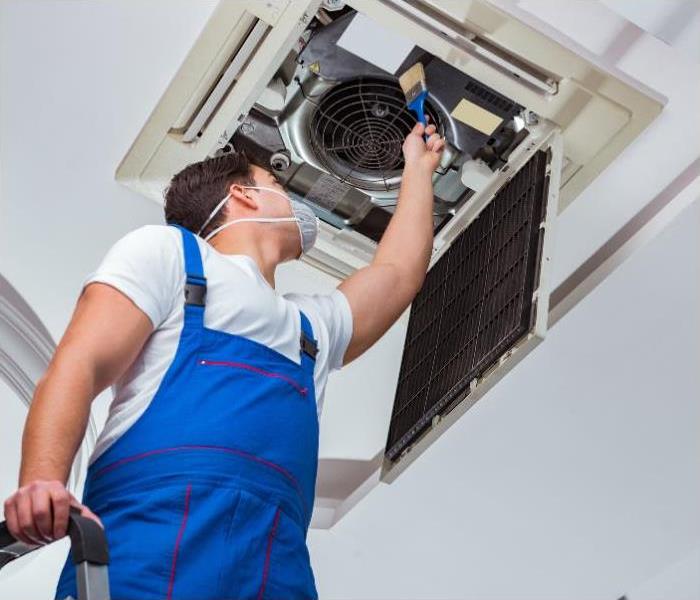 Focus on Indoor Air Quality in North Central Colorado Spring
Focus on Indoor Air Quality in North Central Colorado Spring
As the chill of winter melts away and the vibrant colors of spring begin to bloom, it's time to embrace the tradition of spring cleaning in Colorado Springs, CO. With its stunning mountain backdrop and outdoor-oriented lifestyle, Colorado Springs offers a unique setting for refreshing your living space and rejuvenating your mindset. Whether you're a long-time resident or new to the area, these tips will help you tackle your spring cleaning with ease and efficiency.
Plan Ahead:
Before diving into the cleaning frenzy, take some time to plan your approach. Make a checklist of tasks you want to accomplish, prioritize them, and set realistic goals for each day or weekend. Breaking down the process into manageable steps will help prevent overwhelm and ensure nothing gets overlooked.Declutter Mindfully:
Spring cleaning is the perfect opportunity to declutter your home and clear out any unnecessary items that have accumulated over the year. Take a systematic approach to decluttering each room, sorting items into categories such as keep, donate, or discard. In Colorado Springs, consider donating gently used outdoor gear or winter clothing to local shelters or thrift stores.
Embrace Eco-Friendly Cleaning Products:
Protecting the environment is a top priority for many Colorado residents, so why not extend that ethos to your spring cleaning routine? Opt for eco-friendly cleaning products that are safe for both your family and the planet. Alternatively, you can make your own natural cleaners using ingredients like vinegar, baking soda, and essential oils.Focus on Indoor Air Quality:
With Colorado's dry climate and high altitude, maintaining indoor air quality is essential for your health and comfort. Invest in a high-quality air purifier to remove allergens, dust, and pollutants from the air. Don't forget to clean or replace HVAC filters, vacuum carpets and upholstery regularly, and open windows to let in fresh mountain air whenever possible.Pay Attention to Outdoor Spaces:
Spring cleaning isn't just limited to the indoors – outdoor spaces need some TLC too, especially after a long winter. Sweep away debris from pathways and driveways, prune overgrown bushes and trees, and clean outdoor furniture and grill equipment in preparation for al fresco dining and outdoor entertaining.Tackle Seasonal Maintenance Tasks:
Spring is the perfect time to tackle those maintenance tasks that often get overlooked during the rest of the year. Inspect your home's exterior for any damage or wear and tear, such as loose shingles, cracked caulking, or peeling paint. Schedule a professional roof inspection if needed, and clean out gutters to prevent water damage during spring showers.Organize Outdoor Gear:
Living in Colorado Springs means easy access to a wealth of outdoor recreational opportunities, from hiking and biking to skiing and snowboarding. Take stock of your outdoor gear and equipment, organizing it in a way that makes it easy to access and maintain. Consider investing in storage solutions such as racks, bins, or shelving units to keep everything neat and tidy.Involve the Whole Family:
Spring cleaning doesn't have to be a solo endeavor – get the whole family involved for a fun and productive bonding experience. Assign age-appropriate tasks to each family member, set a timer for short bursts of cleaning, and reward yourselves with a family outing or picnic once the work is done.
Support Local Businesses:
When shopping for cleaning supplies or home organization products, consider supporting local businesses in Colorado Springs. From family-owned hardware stores to eco-conscious cleaning companies, there are plenty of options to choose from that align with the values of the community.
Celebrate Your Accomplishments:
Once your spring cleaning is complete, take a moment to celebrate your accomplishments and enjoy your refreshed living space. Light some candles, open the windows to let in the fresh air, and treat yourself to a well-deserved break surrounded by the beauty of Colorado Springs.
Spring cleaning in Colorado Springs is more than just a chore – it's an opportunity to refresh your home, declutter your life, and embrace the spirit of renewal that comes with the changing seasons. By following these tips and embracing the unique qualities of the Colorado lifestyle, you can make your spring cleaning experience both efficient and enjoyable. So roll up your sleeves, put on some music, and get ready to welcome spring with a clean and organized home.
How to Identify a Mold Problem in Your Colorado Springs Home
3/7/2024 (Permalink)
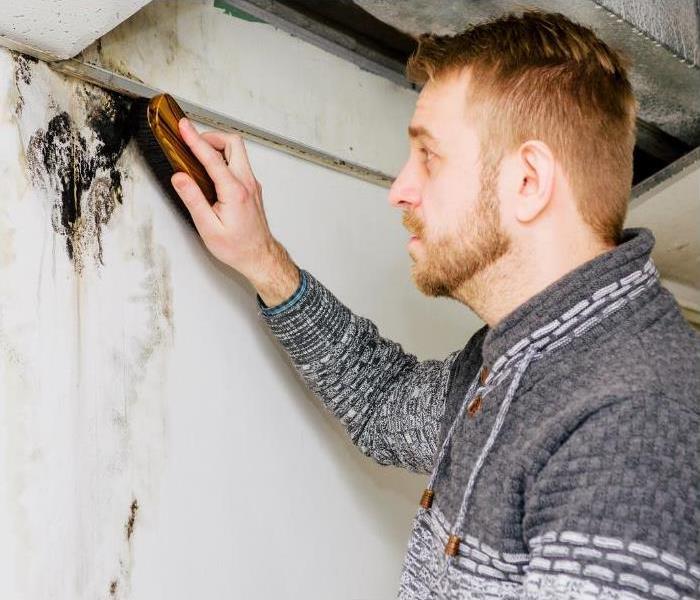 Mold problem in North Central Colorado Spring, UT.
Mold problem in North Central Colorado Spring, UT.
Nestled at the foot of the majestic Rocky Mountains, Colorado Springs is renowned for its stunning landscapes and outdoor adventures. However, beneath the scenic beauty lies a potential threat that can quietly invade your home – mold. Mold growth is a common issue in many households, and Colorado Springs is no exception. The semi-arid climate, occasional heavy rains, and fluctuating temperatures create an environment conducive to mold development. In this blog, we'll explore the signs of a mold problem in your Colorado Springs home and discuss the importance of timely identification and remediation.
Understanding the Colorado Springs Climate
Colorado Springs experiences a unique climate that can contribute to mold growth. With low humidity levels and significant temperature variations, especially between day and night, the conditions are ripe for mold to flourish. The occasional heavy rains during the summer months can also elevate moisture levels, creating an ideal breeding ground for mold spores.
Identifying Common Mold Species
Mold comes in various shapes and forms, with some species posing potential health risks. In Colorado Springs, you may encounter molds like Stachybotrys chartarum (black mold), Aspergillus, Cladosporium, and Penicillium. Each mold species has distinct characteristics, colors, and potential health effects. Recognizing these differences can be crucial in identifying a mold problem in your home.
Visible Signs of Mold
One of the most apparent indicators of a mold issue is visible mold growth. Mold can appear as fuzzy patches, discoloration, or even black spots on walls, ceilings, and other surfaces. Pay close attention to damp or humid areas such as bathrooms, basements, and kitchens, as these are common hotspots for mold growth. If you notice any unusual spots or discoloration, it's essential to investigate further to determine if mold is the culprit.
Musty Odors
Mold often produces a distinct musty odor that can permeate your living spaces. If you catch a whiff of an unpleasant, earthy smell, it could be a sign of hidden mold growth. Pay attention to areas with poor ventilation or high humidity levels, as these are prime locations for mold to thrive. Investigate the source of the odor to identify and address any potential mold problems.
Allergic Reactions
Mold spores can trigger allergic reactions in sensitive individuals. If you or your family members experience unexplained allergic symptoms such as sneezing, coughing, itchy eyes, or respiratory issues, it might be indicative of a mold problem in your home. Consider consulting with a healthcare professional to rule out other causes and take steps to investigate and address any potential mold sources.
Water Leaks and Moisture Issues
Colorado Springs residents are no strangers to occasional heavy rains and snow. These weather events can lead to water leaks, which, if left unattended, create favorable conditions for mold growth. Inspect your home for signs of water damage, such as stained ceilings, peeling paint, or warped walls. Addressing water leaks promptly is crucial in preventing mold proliferation.
Humidity Levels
Low humidity levels are a defining characteristic of Colorado Springs' climate. However, there are instances, especially during the summer months, when humidity levels can rise. Keep an eye on indoor humidity using a hygrometer, aiming to maintain levels between 30-50%. Excessive humidity can create a hospitable environment for mold, making it essential to implement proper ventilation and moisture control measures.
Condensation on Windows
Condensation on windows is a common occurrence in homes, especially during the colder months. However, persistent condensation can indicate elevated humidity levels and poor ventilation, potentially leading to mold issues. Regularly inspect and wipe down windows to prevent moisture buildup and consider implementing measures such as improved ventilation and dehumidification to mitigate mold risks.
Hidden Mold in HVAC Systems
The HVAC (Heating, Ventilation, and Air Conditioning) system in your home plays a crucial role in regulating indoor air quality. Unfortunately, HVAC systems can also harbor hidden mold if not properly maintained. Inspect your HVAC system for signs of mold growth, such as foul odors or visible mold in ducts and vents. Regular professional maintenance can help prevent and address mold issues in your home's ventilation system.
DIY Mold Testing Kits
If you suspect a mold problem but can't identify the source, DIY mold testing kits are available. These kits typically include sampling materials and instructions for collecting mold samples from your home. Keep in mind that while these kits can provide initial insights, they may not be as accurate as professional mold testing conducted by certified inspectors. If the DIY test indicates the presence of mold, it's advisable to consult with professionals for a comprehensive assessment.
Professional Mold Inspection
For a thorough and accurate assessment of mold in your Colorado Springs home, consider hiring a certified mold inspector. These professionals have the expertise and equipment to identify hidden mold, assess the extent of the problem, and provide recommendations for remediation. A professional inspection is particularly crucial if you suspect extensive mold growth or if there are underlying structural issues contributing to the problem.
Identifying a mold problem in your Colorado Springs home requires vigilance, especially in a climate prone to temperature fluctuations and occasional heavy rains. By staying alert to visible signs, monitoring indoor humidity, addressing water leaks promptly, and conducting periodic inspections, you can safeguard your home and family from the potential health risks associated with mold. If you suspect a mold issue, don't hesitate to seek professional assistance for a comprehensive assessment and effective remediation. With proactive measures, you can enjoy the breathtaking beauty of Colorado Springs without the silent threat of mold lurking within your home.
Navigating Water Damage in Colorado Springs with SERVPRO's Expertise
1/12/2024 (Permalink)
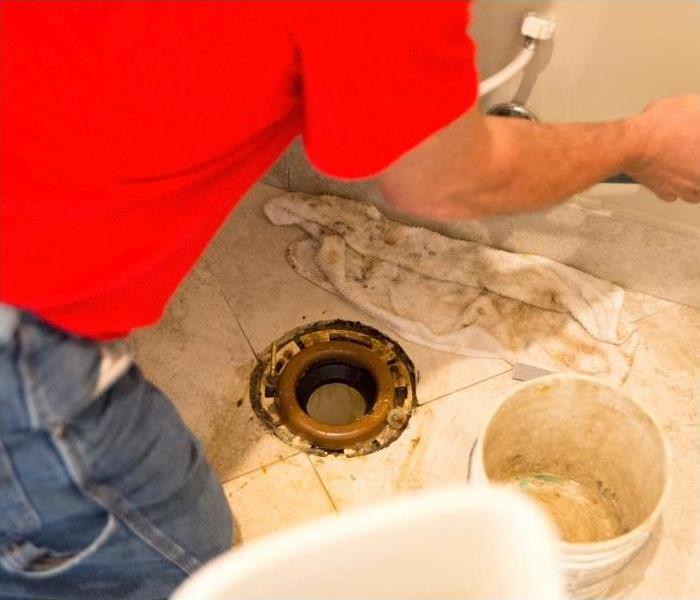 Leaking toilet in Colorado Springs, CO.
Leaking toilet in Colorado Springs, CO.
Colorado Springs, CO, with its stunning landscapes and thriving community, is a place where homeowners take pride in their properties. However, the serenity of this picturesque city can be disrupted by unexpected events, such as water damage caused by a leaking toilet. In this comprehensive blog, we'll delve into the nuances of water damage, its potential consequences, and how we, a renowned restoration company, can be your beacon of hope in restoring your home to its former glory.
Understanding the Impact of Water Damage
Leaking Toilets: The Unseen Menace
Leaking toilets often go unnoticed until the damage is already underway. Whether it's a slow leak or a sudden burst, the consequences can be severe. In a city like Colorado Springs, where homes are nestled against the backdrop of nature, the effects of water damage can be compounded.
Immediate Consequences
The moment water infiltrates your home, it starts to seep into various materials. From drywall to flooring and even the foundation, the immediate impact is far-reaching.
Structural Integrity Under Threat
Over time, prolonged exposure to water can compromise the structural integrity of your home. What might start as a small leak can escalate into a major issue, necessitating costly repairs.
Mold's Silent Invasion
Colorado's unique climate, characterized by dry air and high altitude, doesn't exempt homes from the risk of mold growth. Water damage creates the ideal conditions for mold and mildew, posing not just structural but also health risks to residents.
Our Advantage:
Rapid Response in the Rockies
We understand the urgency of water damage. Their 24/7 emergency services ensure that a team of experts is at your doorstep promptly, ready to mitigate the damage and prevent further escalation.
State-of-the-Art Equipment
Equipped with cutting-edge technology, we employ advanced drying equipment, moisture meters, and thermal imaging to assess and address water damage with precision. This ensures that no corner of your home is overlooked during the restoration process.
Comprehensive Restoration Expertise
The skilled technicians bring a wealth of experience to the table. From water extraction to thorough drying and sanitization, they handle every aspect of the restoration process meticulously.
Navigating the Insurance Maze
Dealing with insurance claims can be a daunting task, especially when you're already dealing with the aftermath of water damage. SERVPRO's professionals work closely with insurance companies, streamlining the claims process and alleviating the burden on homeowners.
The Restoration Journey:
Emergency Response
When you discover a leaking toilet or any other water damage in your Colorado Springs home, time is of the essence. SERVPRO's rapid response ensures that the damage is assessed promptly, and the necessary measures are put in place to prevent further harm.
Water Extraction and Drying
Utilizing state-of-the-art equipment, SERVPRO's technicians commence with water extraction to remove excess moisture. This is followed by an intensive drying process, using dehumidifiers and air movers to ensure that all affected areas are thoroughly dried.
Sanitization and Deodorization
Water damage often brings unpleasant odors and the risk of microbial growth. We don't just stop at drying; they go the extra mile to sanitize affected areas, ensuring a clean and safe environment for you and your family.
Restoration, Not Just Repairs
We believe in restoring, not just repairing. Their team works diligently to bring your home back to its pre-damage condition, addressing not only visible damage but also potential hidden issues.
Ongoing Monitoring
Even after the visible signs of water damage are addressed, we don't walk away. They continue to monitor moisture levels to ensure that your home remains dry and free from the risk of future issues.
Restoring Peace of Mind in Colorado Springs
Choosing us for water damage restoration in Colorado Springs is not just about fixing your home; it's about restoring your peace of mind. In a city known for its tranquility and natural beauty, homeowners can rest assured that their property is in capable hands.
Water damage from a leaking toilet may disrupt the harmony of your Colorado Springs home, but with SERVPRO's expertise, it can be transformed from a source of stress to a story of restoration. Don't let water damage linger – take the first step toward reclaiming your home and ensuring a future free from the lingering effects of leaks. Choose us for a comprehensive and effective restoration journey that brings your property back to its luxurious best.
6 Steps to Prevent Frozen Pipes in North Central Colorado Springs, CO.
12/26/2023 (Permalink)
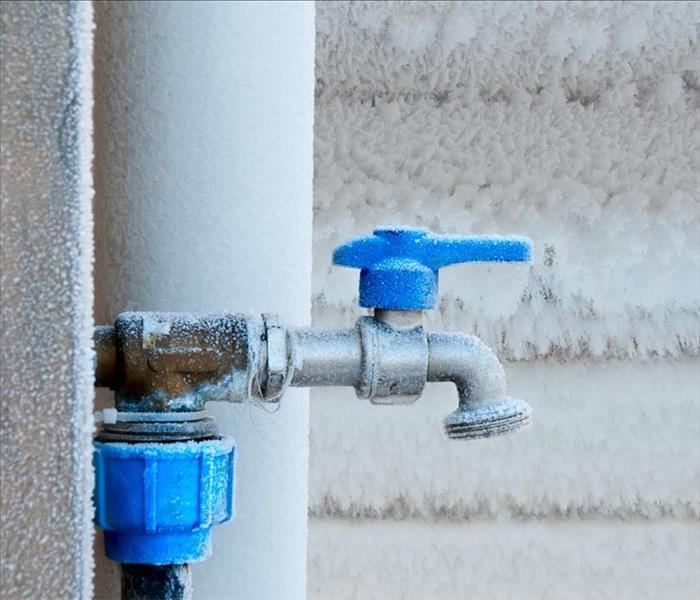 A frozen faucet in Colorado Springs, CO.
A frozen faucet in Colorado Springs, CO.
Winter in Colorado Springs, CO brings with it a magical snowy landscape, cozy fires, and the holiday spirit. However, it also ushers in freezing temperatures that can wreak havoc on your home's plumbing. One of the most common and potentially costly issues during this season is frozen pipes. When temperatures plummet, the water inside pipes can freeze, leading to cracks, bursts, and extensive damage. To help you fortify your home against the winter chill, we've compiled a comprehensive guide with six effective strategies to prevent your pipes from freezing in Colorado Springs.
6 Strategies to Prevent Frozen Pipes
1. Insulate:
Proper insulation is the first line of defense against frozen pipes. In a region where winter temperatures can be particularly harsh, it's crucial to ensure that all exposed pipes are well-insulated. Start by identifying pipes in vulnerable areas such as attics, basements, and crawl spaces. Foam pipe insulation is a cost-effective and efficient solution, wrapping around pipes to provide a protective barrier against the cold. Additionally, consider using heating tape for an extra layer of warmth, especially in areas prone to extreme cold.
Don't forget about areas where cold air might find its way into your home. Check for gaps or cracks in your home's foundation and walls and seal them promptly. By fortifying your home's envelope, you not only protect your pipes but also enhance your overall energy efficiency.
2. Keep Your Home Warm:
Maintaining a consistent indoor temperature is key to preventing frozen pipes. While it might be tempting to lower your thermostat to save on heating costs, the risk of frozen pipes increases with a significant temperature drop. Aim to keep your home at a minimum of 55 degrees Fahrenheit, even when you're away. This not only protects your pipes but also ensures a comfortable living environment.
Investing in a smart thermostat can be a wise decision. These devices allow you to program your heating system efficiently, ensuring that your home stays warm when needed and conserving energy when you're not around. Some smart thermostats even provide alerts if the temperature inside your home drops to a level that could put your pipes at risk.
3. Let the Faucets Drip:
Running water, even at a trickle, can be a simple yet effective strategy to prevent pipes from freezing. When water flows through the pipes, it relieves pressure and reduces the risk of freezing. Focus on faucets connected to pipes that run through unheated or poorly insulated areas, such as those in exterior walls.
It's important to note that the goal is not to waste water but to create a steady flow that discourages freezing. During particularly cold nights, letting faucets drip in different parts of your home can provide added protection. This proactive measure is especially useful for homes with a history of frozen pipes or those in areas prone to severe winter weather.
4. Open Cabinet Doors:
Kitchen and bathroom cabinets often house pipes, and these spaces can become quite chilly, especially if they are located against exterior walls. To encourage the flow of warm air around the pipes, keep cabinet doors open during extremely cold weather. This allows the heat from your home's interior to reach the pipes and helps maintain a temperature that discourages freezing.
For added insulation, consider placing a towel or foam board at the back of the cabinet to create a barrier between the pipes and the cold air. By taking this simple step, you enhance the effectiveness of your heating system and reduce the risk of frozen pipes in these vulnerable areas.
5. Seal Leaks and Cracks:
A thorough inspection of your home for potential points of entry for cold air is essential in preventing frozen pipes. Cracks in windows, doors, and foundation walls can allow frigid air to seep in, putting your pipes at risk. Take the time to inspect these areas and seal any gaps using weatherstripping, caulk, or insulation.
Start by examining the exterior of your home, paying attention to window frames, door seals, and any visible cracks in the walls. Move inside and check for drafts near windows and doors. Attics and basements are also common culprits for air leaks. By addressing these issues, you not only protect your pipes but also enhance the overall energy efficiency of your home.
6. Disconnect and Drain Outdoor Hoses:
Outdoor hoses and faucets are particularly vulnerable to freezing temperatures. Before winter arrives in full force, take the time to disconnect and drain all outdoor hoses. Shut off the water supply to exterior faucets and drain any remaining water from the pipes. This prevents water from lingering in the pipes outside and minimizes the risk of freezing and subsequent damage.
Consider installing frost-free hose bibs if your home doesn't already have them. These bibs are designed to prevent water from remaining in the exposed portion of the pipe, reducing the likelihood of freezing. Taking proactive steps to winterize your outdoor plumbing can save you from the headache of dealing with burst pipes when spring arrives.
In conclusion, safeguarding your pipes from freezing in Colorado Springs requires a combination of proactive measures and thoughtful home maintenance. By insulating, regulating indoor temperatures, letting faucets drip, opening cabinet doors, sealing leaks, and disconnecting outdoor hoses, you can significantly reduce the risk of frozen pipes and the headaches that come with them. This winter, take the necessary steps to fortify your home, ensuring a warm and worry-free season for you and your pipes. Remember, a little preparation goes a long way in protecting your home from the winter chill. Stay warm, stay safe!
Winterizing Your Home in Colorado Springs: A Comprehensive Guide to Ensure a Cozy and Damage-Free Season
11/9/2023 (Permalink)
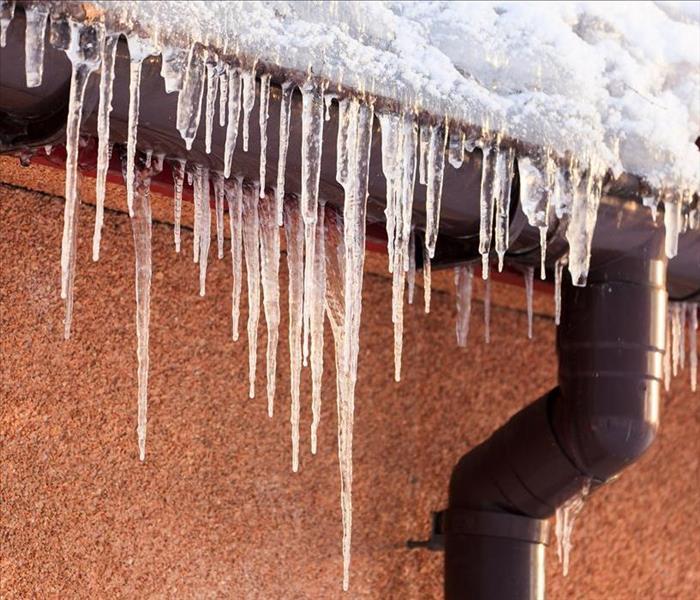 Clogged gutters can lead to ice dams in Colorado Springs, CO.
Clogged gutters can lead to ice dams in Colorado Springs, CO.
As the autumn leaves fall and a chill creeps into the air, residents of Colorado Springs know that winter is just around the corner. While the snow-covered landscapes are undeniably beautiful, the winter season can pose challenges for homeowners. From freezing temperatures to heavy snowfall, it's essential to prepare your home to withstand the elements and avoid costly damage. In this comprehensive guide, we'll delve into a variety of measures you can take to winterize your home in Colorado Springs, CO effectively.
- Sealing the Leaks: Inspect and Seal Windows and Doors
The first line of defense against the winter cold is ensuring that your home is properly sealed. Check for any gaps or cracks in windows and doors, as these can allow cold drafts to enter, making your heating system work harder and increasing energy costs. Utilize weatherstripping and caulk to seal these gaps, creating a more energy-efficient and comfortable living environment.
- Heating System Maintenance: Ensuring Warmth When You Need It
The heart of your winter readiness plan lies in the efficiency of your heating system. Don't wait until the mercury drops to have it inspected. Schedule a professional service to check for any issues, replace filters, and ensure that your heating system is operating at peak performance. Consider upgrading to a programmable thermostat for better control and energy savings.
- Guarding Against Frozen Pipes: Insulation and Prevention
Frozen pipes can wreak havoc on your home, leading to expensive repairs. Insulate exposed pipes in unheated areas, and consider using heat tape for added protection. Disconnect and drain outdoor hoses, and shut off the water supply to outdoor faucets. Taking these precautions will help prevent freezing and ensure a steady flow of water throughout the winter.
- Clearing the Way: Gutter Maintenance for Ice Dam Prevention
Clogged gutters can lead to ice dams, which can cause damage to your roof and interior spaces. Clean gutters and downspouts of leaves and debris to allow for proper drainage. Ensure that downspouts direct water away from your home's foundation to prevent ice buildup. Consider installing gutter guards to minimize the accumulation of debris.
- Up on the Rooftop: Roof Inspection and Maintenance
Your roof bears the brunt of winter weather, and it's crucial to inspect it for any vulnerabilities. Check for loose or damaged shingles and address them promptly. Look for signs of leaks and ensure that your attic is adequately insulated to prevent ice dams. If you're uncertain about your roof's condition, consult with a professional roofing contractor.
- Winter Essentials: Stocking Up for Storms
Prepare for winter storms by stocking up on essential supplies. Rock salt, snow shovels, and emergency kits should be readily available. Create an emergency kit with flashlights, batteries, blankets, and non-perishable food items in case of power outages. Being prepared ensures that you can weather the storm comfortably and safely.
- Landscaping for Winter: Trim, Clear, and Protect
The winter landscape may be harsh, and your landscaping should be adapted accordingly. Trim tree branches that could pose a threat under the weight of snow or ice. Clear dead vegetation from around your property to reduce fire hazards and make snow removal more manageable. Consider using burlap or other protective coverings for delicate plants.
- Insurance Check: Reviewing Your Coverage
Before winter arrives in full force, take the time to review your homeowner's insurance policy. Ensure that it provides adequate coverage for winter-related damage, including snow and ice damage. Understand the specifics of your policy, and make any necessary adjustments to guarantee comprehensive protection for your home.
As winter approaches, taking these proactive measures can make all the difference in safeguarding your home against the challenges of the season. From insulating windows to maintaining your heating system and preparing for winter storms, a comprehensive approach ensures that your home remains warm, comfortable, and free from winter-related damage. By investing the time and effort now, you'll enjoy a worry-free winter in the picturesque surroundings of Colorado Springs. Stay cozy, stay prepared!
The Comprehensive Guide to Fire Damage Restoration in Colorado Springs, CO
10/19/2023 (Permalink)
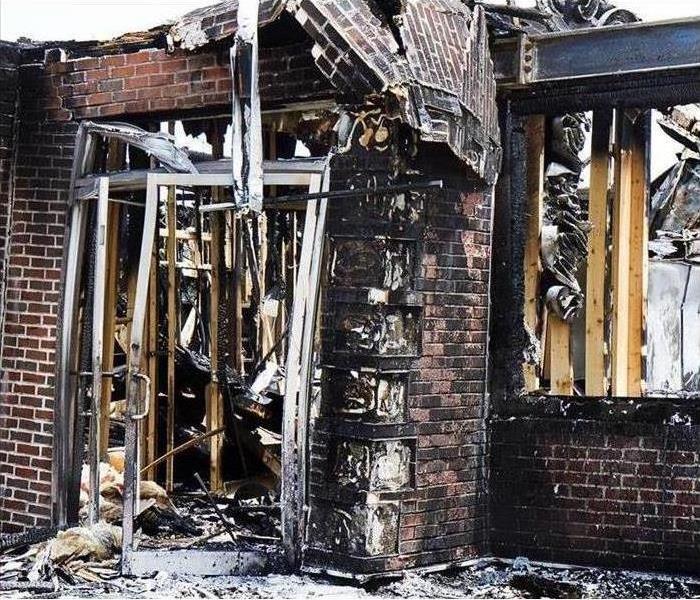 Fire damaged home in Colorado Springs, CO.
Fire damaged home in Colorado Springs, CO.
Facing a fire in your home is a devastating and overwhelming experience. Beyond the immediate danger of the flames, the aftermath often leaves homeowners grappling with the emotional and logistical challenges of recovery. Fire damage can range from charred walls and smoke-stained ceilings to water damage from firefighting efforts. The process of restoring your home can seem daunting, but there is hope. In this comprehensive guide, we will take an in-depth look at the 4-step fire restoration process that SERVPRO of North Central Colorado Springs follows to help homeowners rebuild and reclaim their lives after suffering fire damage.
The 4-Step Fire Restoration Process
Step 1: Assessment and Inspection
The first step in the fire restoration process is the assessment and inspection of the damaged property. This initial phase is critical as it sets the foundation for the entire restoration plan. SERVPRO of North Central Colorado Springs deploys experienced professionals who meticulously examine every aspect of your home affected by the fire.
Damage Evaluation: The assessment begins with a detailed evaluation of the extent of damage. This includes the visible signs of fire and smoke damage but also extends to less apparent issues like structural damage, compromised electrical and plumbing systems, and potential health hazards.
Salvageable Items: During the assessment, the team identifies items and materials that can be salvaged. This can include valuable personal belongings, furniture, and sentimental items. A comprehensive inventory is created to guide the restoration process.
Restoration Plan: The assessment phase results in a detailed restoration plan tailored to the specific needs of your property. Each plan is unique, addressing the individual characteristics of your home and the extent of the damage.
Insurance Coordination: We work closely with your insurance company to ensure that you receive fair coverage. This collaborative approach is designed to streamline the claims process, and it aims to guarantee that no damage is overlooked.
Step 2: Mitigation and Securement
Once the assessment is complete, the next critical step is mitigating further damage and securing the property. This is essential to prevent additional harm and ensure the safety of your home.
Securing the Property: After a fire, your home may be exposed to the elements, vandalism, or theft. SERVPRO of North Central Colorado Springs takes immediate action to secure your property. This includes boarding up windows, doors, and any other openings that may pose a security risk.
Addressing Water Damage: In many cases, water is used to extinguish the fire, resulting in water damage. This step is crucial for your safety and the preservation of your property. SERVPRO's team uses specialized equipment to remove excess water and moisture, preventing further damage and the growth of mold.
Step 3: Cleanup and Restoration
With the property secure and free from additional damage, the focus shifts to the cleanup and restoration phase. This is where our team of experts works to return your home to its pre-fire condition.
Removal of Soot, Smoke, and Residue: The cleanup phase involves the meticulous removal of soot, smoke, and fire residue from all surfaces. This process employs advanced techniques and cleaning products to ensure that your home is not only clean but also free from harmful substances.
Odor Control: The team also addresses odors associated with fire damage. This involves the use of advanced deodorization techniques to ensure that your home smells fresh and clean once more.
Structural Repairs: If structural damage has occurred, we will work to repair and restore your home. This includes rebuilding walls, replacing damaged insulation, and addressing compromised electrical and plumbing systems. The goal is to make your home safe, functional, and aesthetically pleasing again.
Step 4: Final Inspection and Rebuilding
The final step in the fire restoration process involves a thorough inspection to ensure that all work has been completed to exacting standards. This step is critical as it provides homeowners with the assurance that their home is safe, clean, and free from any residual damage.
Quality Assurance: We take pride in our commitment to quality and customer satisfaction. During the final inspection, every aspect of the restoration process is evaluated to ensure that it meets our high standards.
Rebuilding: Once the final inspection is complete and the homeowner is satisfied, the process of rebuilding and restoring the home begins. We work with experienced contractors to ensure that your home is not only structurally sound but also visually appealing and functional. Homeowners are actively involved in the decision-making process throughout the restoration phase.
Recovering from a fire in your Colorado Springs, CO home is an arduous journey, but with the right partner by your side, you can reclaim your life and restore your property. SERVPRO of North Central Colorado Springs is dedicated to guiding you through the 4-step fire restoration process, from the initial assessment to the final rebuilding, with a commitment to making the process as smooth and stress-free as possible. Your home's future begins with the expertise, care, attention to detail, and dedication that we bring to each and every restoration project. In the face of adversity, there is hope, and your home's restoration is a testament to the power of resilience and expert care.
What Is the Difference Between Mold and Mildew?
9/11/2023 (Permalink)
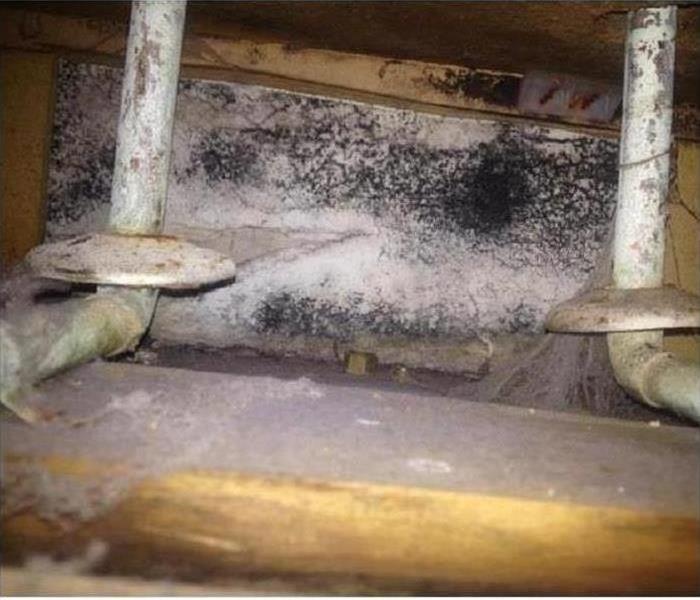 Mold growth in residential home in Colorado Springs, CO.
Mold growth in residential home in Colorado Springs, CO.
Mold damage in your home in Colorado Springs, CO can be costly to remove, but many people don’t know the differences between mold and mildew growth. Understanding the differences between mold and mildew can help you know how to react if either is growing in your home.
Diference Between Mold and Mildew
1. Mildew Causes Less Damage
One of the primary differences between mold and mildew is the amount of damage they cause. Though mildew can cause damage to a home, the damage is generally cosmetic and does not require an extensive restoration process. However, mold can cause significantly more damage, like structural damage, to homes because it can grow on a variety of surfaces.
2. Visual Differences
One way to identify whether it is mold or mildew growing in your home is to examine the appearance of the growth. Mildew often is described as a flat layer since it tends to grow on flat surfaces and is generally gray or white in color. Alternatively, mold is often fuzzy in appearance and can be a variety of colors depending on the type of mold damage.
3. Mold Is Invasive
Certain environments make it easier for both mold and mildew to grow, but mold is generally able to grow in more places than mildew. While mildew may grow on shower curtains or on damp clothing, mold is far more invasive and can grow on drywall, ceilings and other areas in the home. Though both mold and mildew thrive in warm, humid environments, some types of mold are capable of growing in cold areas, too, and may grow in refrigerators and other cool places.
Knowing the difference between mildew growth and mold growth can help you know how to react if your home is affected by mold damage. If you need assistance with restoring your home after it has been damaged by mold, it could be helpful to work with mold remediation experts.
How To Use a Fire Extinguisher for a Home Fire
8/31/2023 (Permalink)
 It is essential to have an extinguisher in your Colorado Springs, CO home to prevent the fire spread.
It is essential to have an extinguisher in your Colorado Springs, CO home to prevent the fire spread.
A house fire can happen without warning and get out of control in an instant. Many people don't think about this scenario until it's too late, so it's helpful to learn about the different types of house fires and how to prevent or mitigate fire damage.
Three types of fire extinguishers are used in homes:
- Type A extinguishers are manufactured to manage common materials fires (e.g., paper, cloth, wood).
- Type B extinguishers are created for use with flammable and combustible liquids (e.g., oil, grease, gasoline).
- Type C extinguishers are built to control electrical fires (e.g., appliances, televisions, hairdryers, power tools).
Ideally, you'll have a fire extinguisher accessible in different areas of your Colorado Springs, CO, home for the type of fire that is most likely. For example, type A for an office or living room, type B for a garage or kitchen, and type C for a hallway or recreational room.
Tips for Avoiding Fire Damage
- Be Careful With Candles
Candles can give the room a pleasant scent while providing an atmosphere that doesn't compare with light bulbs. However, you must be very careful with candles. Keep them on a sturdy surface and away from flammable materials (e.g., curtains, papers). Also, never leave them burning unattended and leave them out of reach of children and pets.
- Maintain Your Dryer
Remember to clean your lint trap every time you do a new load of laundry. Fire damage restoration experts will advise you to also clean behind the dryer to clear it of lint and clothing items. These materials can be highly flammable when exposed to the heat of the dryer.
- Keep Toaster, Stove, and Oven Clean
Keep your kitchen cooking appliances such as your toaster, stove, and oven clean. Crumbs, oil, and grease can flame up quickly when the surface gets hot.
- Have Working Fire Extinguishers on Hand
Always have an easily accessible fire extinguisher for every part of your home. Inspect them regularly to make sure they will work when you need them.
- Monitor Cooking Food
Avoid a kitchen fire by closely watching cooking food. Don't leave the kitchen area unattended while you're cooking. Teach everyone how to put out different types of kitchen fires safely.
- Maintain Smoke Detectors
It's vital to your family's well-being to have working smoke detectors in every part of your home and maintain them. Make sure you replace the battery in each detector at least twice a year and test the alarm. Also, keep them free of dust and debris that can build up. You can lightly vacuum, blow with canned air or wipe the casing off with a damp cloth.
- Safely Store Combustible Products
You may be surprised at how many products in your household can combust relatively easily. Keep these materials, such as hairspray, air fresheners, household cleaners, and shaving cream, away from heat sources like space heaters.
The key to avoiding a house fire is knowing what to do and not to do to be safe. Being cautious around heat sources and open flames is essential. Ensure everyone knows how to safely put out different types of fires and how to use a fire extinguisher.
My Basement Has Flooded! Now What?
8/31/2023 (Permalink)
 Be sure to clean water damage after a flood in your Colorado Springs, CO home as quickly as possible to avoid further damage.
Be sure to clean water damage after a flood in your Colorado Springs, CO home as quickly as possible to avoid further damage.
When you discover that your Colorado Springs, CO, basement has flooded, panic tends to ensue, especially if water is still flowing in. How do you stop and extract the water? Is anything going to be salvageable? How do you even restore the area after flooding? These are some of the main questions people ask during a basement flood. Fortunately, all hope is not lost; there are ways to restore much of a water-damaged area and its contents. When it comes to water damage, every second counts, so act quickly.
What Are the Steps for Remediation?
- Prioritize Safety
Most importantly, you and others in the area must remain safe. Before you even step into the basement, turn off the electricity to the basement or the entire house. Electricity can flow through standing water if it's in contact with electronics, appliances, or electrical outlets. If you can't safely navigate to the circuit breaker, call a professional electrician or your power company to turn your electricity off.
- Stop the Water
If the water is still flowing into the basement and it's from a burst pipe or another plumbing issue, shut off the main water supply to stop the water. You can call for pipe repair after you've started the restoration process.
- Wear PPE
If the flood originated outdoors or contains sewage or another toxic substance, it's vital to wear personal protective equipment. This PPE not only keeps you and others in the area safe but also prevents cross-contamination to other parts of the house.
- Eliminate Standing Water
You must extract standing water as quickly as possible. Every minute counts when it comes to water damage, as the damage progresses rapidly. The time it takes to eliminate the water could mean the difference between something being salvageable or not.
- Remove Contents
Remove all affected items from the area. This not only includes basement contents but could also include carpeting and carpet padding, hardwood flooring, and drywall. Flooding will soak carpet and padding; it probably won't be dried quickly enough to save. Wet wood tends to warp and buckle and probably won't be salvageable. Drywall will soak up water like a sponge. You will likely have to cut out the wet parts of your drywall and replace them. Contents such as upholstered and wooden furniture will have to be assessed for salvageability.
- Begin Drying
Mold can start growing within 24 hours of moisture exposure, so everything needs to be completely dried as quickly as possible. If you can't dry it within 48 hours, it probably won't be salvageable. The basement itself will also have to be dried thoroughly as quickly as possible to avoid mold growth. It's best to hire water damage restoration professionals to do this job, as they have the expertise and industrial equipment to handle the job safely and efficiently. In the meantime, you can run fans and dehumidifiers to dry the area faster. Heat will also help the drying process.
- Clean Everything
You'll need to clean and disinfect everything to ensure no lingering bacteria, mold spores or other harmful substances remain. Everything that the water touched must be cleaned, including walls and furniture.
When you discover flooding in your basement, time is precious. The sooner you can begin drying, the more of the affected items you can save.
Sewage Has Backed Up Into My Bathtub! Now What?
8/18/2023 (Permalink)
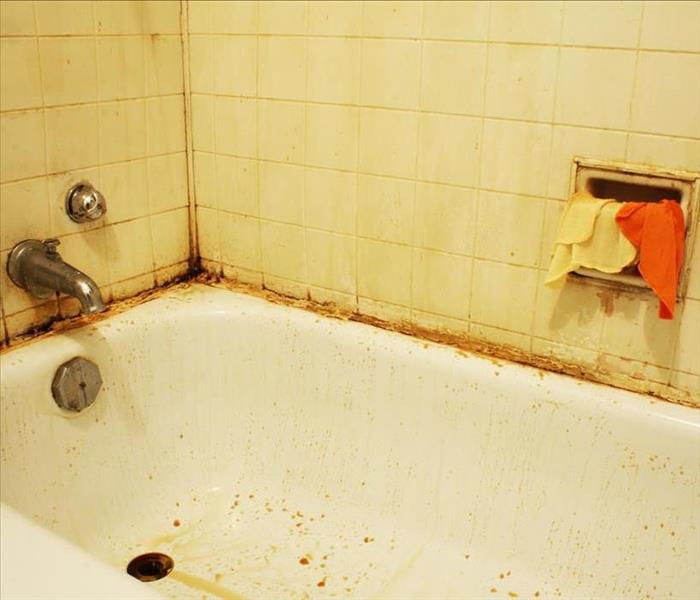 Sewage back up in Colorado Springs, CO.
Sewage back up in Colorado Springs, CO.
No one expects a sewer backup, much less to encounter raw sewage backing up into their Colorado Springs, CO, bathtub. Unfortunately, it is a possibility that some homeowners must face at some point. It's essential to get the problem solved as soon as possible to avoid the various hazards resulting from sewage going where it shouldn't.
7 Steps for Dealing With a Bathtub Backup
The key to appropriately dealing with a sewage backup is to clean the area thoroughly while preventing cross-contamination into unaffected areas. There are several basic steps for accomplishing these goals safely.
1. Keep Everyone Out of the Affected Area
First, it's critical to keep everyone not working in the affected area out until it's safe, especially children and pets. Raw sewage needs to be handled with care to not spread the bacteria even more than it has already dispersed.
2. Turn Off the Electricity
If there is a chance that the standing water has come into contact with electrical outlets or plugged-in electronics, shutting off the electricity before entering the area is vital. An electric current could be traveling through the water, so if you can safely reach the breaker box, turn off the electricity to the affected area or the whole house.
3. Protect Yourself With Personal Protective Equipment
When dealing with raw sewage, anyone working in the area needs to protect themselves as much as possible. Sewage carries germs, bacteria and diseases that can be hazardous if people encounter them unprotected. Therefore, you must put on PPE before entering the affected area. Then, you must remove the PPE every time you exit the area to prevent cross-contamination to other parts of your home.
Depending on the severity of the sewer backup, you may choose to wear only a few PPE items such as protective glasses, a respirator and latex gloves. You could also wear hair coverings, coveralls and shoe coverings for more protection.
4. Extract All Water
Removing the standing water could be relatively quick and straightforward if you have a wet/dry vacuum; it can also remove small debris. If not, a mop and towels may have to suffice. Hiring water damage restoration specialists is typically the best solution because these workers have the expertise and industrial-grade equipment to ensure a quality, thorough job.
5. Dispose of Unsalvageable Materials
Anything porous item that has soaked up the water probably will be unsalvageable, as you may not be able to clean and dry it thoroughly. You must throw out these materials, which could include things like wood flooring, carpet, wooden furniture, wooden cabinets and drywall.
6. Clean and Sanitize Everything That Remains
Cleaning and sanitizing the entire affected area and its contents is one of the most critical parts of the job after sewage flooding. You can purchase products in stores or simply make a bleach/water solution. Everything must be wiped down with this mixture.
7. Dry Everything Completely
To avoid more water damage and mold growth, you will need to quickly and completely dry all that remains. You can turn on the ventilation fan in the bathroom, open windows and doors, and run dehumidifiers, heaters and fans.
It's always beneficial to be proactive when it comes to home issues. If you discover a sewer backup, remember to perform these basic steps to mitigate the damage.



 24/7 Emergency Service
24/7 Emergency Service









